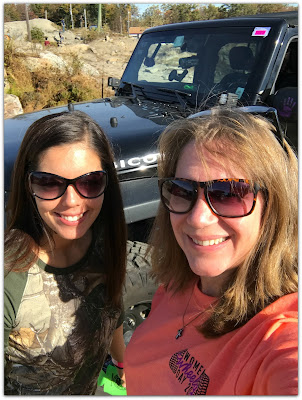Banged-Up Rear Control Arm Bracket
While my Jeep was in the shop for a routine oil change, my tech pointed out something I hadn’t fully noticed — my rear lower control arm brackets were taking a beating.
Here’s how I discovered the problem, learned what those brackets actually do, and took steps to protect one of the most vulnerable spots on a Jeep Wrangler.
Spotting the Damage
The rear control arm brackets sit low on the underside of the Jeep, making them one of the first points to hit rocks when off-roading.
 |
| Banged Up Rear Control Arm Bracket |
Over time, I noticed scrapes and dents from trail rides — nothing major at first, but enough to start deforming the shock bolts that mount near the bracket.
 |
| Scraped up Bolt from the Rocks. |
These little hits might seem minor, but they add up. Bent brackets can throw off suspension geometry and make future repairs more difficult.
🧠 Jeep Momma Tip: During every oil change or tire rotation, take a few minutes to inspect your suspension brackets and mounts. Catching small issues early prevents expensive trail damage later.
A Lesson in Lower Control Arms
When I first got my Jeep, the idea of welding on new parts sounded intimidating. But as I’ve learned more about off-roading and vehicle protection, I’ve come to appreciate that armor isn’t optional — it’s essential.
So when my shop suggested adding weld-on control arm skids, I jumped at the opportunity.
 |
| Mike Welding on Skid Plates |
These skid plates were the first parts I ever had welded onto my Jeep — and it marked a big milestone in my off-road learning journey.
Rear Control Arm Skid Plates: Why They Matter
The rear control arm skids protect both the control arm joints and the rear shock mounts, which are known weak points for trail rigs. Without reinforcement, those brackets can bend or crack after repeated rock contact.
These particular skids are:
-
Made from 3/16-inch steel
-
Laser cut and CNC bent for precision
-
Designed to fit perfectly over the JK rear control arm brackets
-
Fully weld-on, providing long-lasting strength and coverage
Once installed, they act like armor — deflecting rocks, absorbing hits, and preventing further bracket deformation.
 |
| Rear Shock |
Rear Shock Protection
Beyond the control arms, these skid plates also protect the lower shock mounts from direct impact. That extra bit of coverage keeps the shock bolts straight and prevents premature wear on your suspension components.
🧠 Pro Tip: If you do a lot of rock crawling, inspect your shocks and mounts frequently. Even with armor, debris can bend or loosen hardware over time.
Shout Outs & Lessons Learned
A big shout out to Adrenaline Off Road for recommending this mod — I wouldn’t have even known it existed!
And special thanks to Mike, my patient tech, who took the time to explain each step of the welding process so I could understand how these skids integrate into my Jeep’s suspension system.
More Jeep Momma Modifications and Accessories
📅 Update 2024: After years of trail use, these skids have taken countless hits — and they’re still holding strong. They’ve definitely saved my control arm brackets from serious damage.
 |
| Mike working on my mounts. |
FAQs: Jeep Rear Control Arm Brackets & Skid Plates
1. What does a rear control arm bracket do?
The rear control arm bracket connects your Jeep’s axle to the frame, maintaining proper suspension geometry. It’s essential for ride stability and articulation.
2. Why do control arm brackets get damaged?
They’re a low point on the Jeep, especially on lifted Wranglers. When rock crawling or driving uneven trails, they’re often the first components to scrape or hit rocks.
3. Do I need skid plates if I don’t off-road often?
Even light trail use or gravel roads can cause wear over time. Skid plates protect these vital mounting points and are a worthwhile upgrade for any Jeep owner.
4. Can I install skid plates myself?
Some bolt-on versions exist, but weld-on skids provide stronger protection. If you don’t have welding experience, a 4x4 shop or off-road fabricator can install them quickly.
5. What thickness steel is best for skid plates?
3/16-inch steel is the industry standard for balance between protection and weight. Anything thinner won’t hold up well against repeated impacts.





































